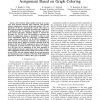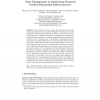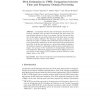NOMS
2010
IEEE
13 years 9 months ago
2010
IEEE
The trend for future mobile networks is to move away from Network Elements (NEs) delivered with specially tailored configurations towards off-the-shelf products. The configurations...
NOMS
2010
IEEE
13 years 9 months ago
2010
IEEE
Crash and omission failures are common in service providers: a disk can break down or a link can fail anytime. In addition, the probability of a node failure increases with the num...
MOBILIGHT
2010
13 years 9 months ago
2010
MOBILIGHT
2010
13 years 9 months ago
2010
MOBILIGHT
2010
13 years 9 months ago
2010
Abstract. This paper describes a framework for the design space exploration of resource-efficient software-defined radio architectures. This design space exploration is based on a ...
MOBILIGHT
2010
13 years 9 months ago
2010
Network Coding (NC) has witnessed a tremendous upsurge in interest and activities in recent years, both in academia and industry. Indeed, since the pioneering publication of Ahlswe...
MOBILIGHT
2010
13 years 9 months ago
2010
Advancements in network technologies dramatically increased management complexity. Cognitive networking was introduced to deal with this problem, by providing algorithms for autono...
MOBILIGHT
2010
13 years 9 months ago
2010
This paper proposes and assesses a new distributed simulation platform for heterogeneous wireless communications. The objective of the ICARUS platform is to investigate cross-layer...
MOBILIGHT
2010
13 years 9 months ago
2010
Abstract. A comparison between time and frequency domain TOA estimators compliant with the 802.15.4a Standard has been made. The time domain estimator is done in two stages. One ha...
MOBILIGHT
2010
13 years 9 months ago
2010
Abstract. Mobile network operators demand small base station antennas and high physical layer throughputs. In the downlink, high physical layer throughputs can be achieved by explo...



